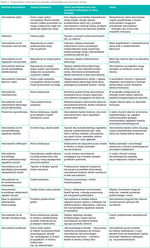ABSTRACT
The management of difficult-to-heal wounds
Chronic wounds do not heal due to uncorrected problems associated with an underlying disease. In a majority of chronic wounds, healing processes do not follow a normal physiological pattern in that they do not progress beyond the inflammatory or proliferative phase. The most common types of chronic wounds in Poland are venous leg ulcers, pressure ulcers, diabetic foot ulcers, ischemic wounds and neoplastic ulcerations. There are also less common chronic wounds, such as rheumatoid, pyodermic, vasculitic, hypertensive and infectious wounds as well as other atypical ulcerations. The local management of chronic wounds should follow the TIME strategy. Nonetheless, each type of chronic wound requires a specific and targeted treatment, e.g. venous leg ulcers require compression therapy while diabetic neuropathic foot ulcers require offloading. Another important problem associated with chronic wounds is the need to establish a correct diagnosis. For non-healing wounds, an alternative diagnosis should be considered, including rarely observed chronic wounds.
Zalecane piśmiennictwo
1. Andriessen A, Apelqvist J, Mosti G, et al. Compression therapy for venous leg ulcers: risk factors for adverse events and complications, contraindications – a review of present guidelines. J Eur Acad Dermatol Venereol 2017;31(9):1562-8
2. Bus SA, Lavery LA, Monteiro-Soares M, et al.; International Working Group on the Diabetic Foot. Guidelines on the prevention of foot ulcers in persons with diabetes (IWGDF 2019 update). Diabetes Metab Res Rev 2020;36(Suppl 1):e3269
3. Falanga V, Romanelli M, Ágreda JJS, et al. Wound bed preparation in practice. European Wound Management Association Position document. London: Medical Education Partnership, 2004
4. Hinchliffe RJ, Forsythe RO, Apelqvist J, et al.; International Working Group on the Diabetic Foot (IWGDF). Guidelines on diagnosis, prognosis and management of peripheral artery disease in patients with foot ulcers and diabetes (IWGDF 2019 update). Diabetes Metab Res Rev 2020;36(Suppl 1):e3276
5. Jawień A, Szewczyk MT, Kaszuba A i wsp. Wytyczne ekspertów w sprawie gojenia owrzodzeń żylnych goleni. Leczenie Ran 2011;8(3):59-80
6. Jawień A, Bartoszewicz M, Przondo-Mordarska A i wsp. Wytyczne postępowania miejscowego i ogólnego w ranach objętych procesem infekcji. Leczenie Ran 2012;9(3):59-75
7. Lavery LA, Davis KE, Berriman SJ, et al. WHS guidelines update: diabetic foot ulcer treatment guidelines. Wound Repair Regen 2016;24(1):112-26
8. Powers JG, Higham C, Broussard K, et al. Wound healing and treating wounds: Chronic wound care and management. J Am Acad Dermatol 2016;74(4):607-25
9. Simka M. TIME – nowoczesna strategia leczenia ran przewlekłych. Pol Przegl Chir 2005;77:748-60
10. Tan MKH, Luo R, Onida S, et al. Venous leg ulcer clinical practice guidelines: what is AGREEd? Eur J Vasc Endovasc Surg 2019;57(1):121-9
11. Urbanek T (red.). Owrzodzenie żylne goleni. Podręcznik. Katowice: Samodzielny Publiczny Szpital Kliniczny nr 7 Śląskiego Uniwersytetu Medycznego w Katowicach, Górnośląskie Centrum Medyczne im. prof. Leszka Gieca, 2016
12. Vowden P, Cooper RA. An integrated approach to managing wound infection. European Wound Management Association Position Document. London: Medical Education Partnership, 2006
